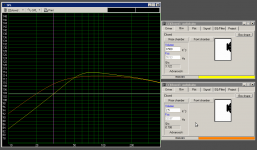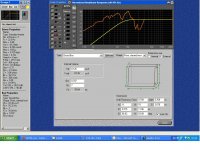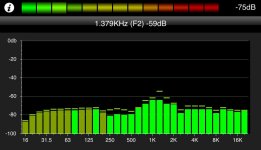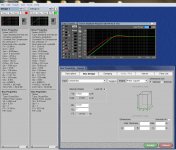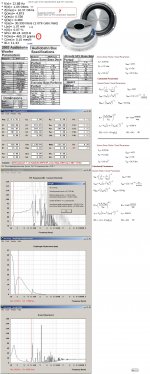^ Ah, like one of those bass-shaker thingies. Never thought about that before. With a 1 pound moving mass it just might have that sort of effect if the box is properly coupled to the vehicle.
I would try to give them a little more box space than "as small as they will fit in" myself. 0.5ft^3 per driver is about as small as I would suggest. Larger would be better....
The graph below shows a pair of the drivers you are looking at, compared first, crammed into 0.5ft^3 of space (0.25ft^3 per driver, yellow plot) vs the same drivers, given 2.5ft^2 space (1.25ft^2 per driver, orange plot). In each case, your Pe as limited by Xmax stays above 500W per driver right down to 10hz so you can work to the full capabilities of the amp (provided it is clean) in either case without a power or excursion limitation.
Notice the larger box improves efficiency at 30hz by about 6dB. Another way to put it is that, the larger box can play 30hz at 250W, as loud as the smaller box will do it with 1000W.
The graph below shows a pair of the drivers you are looking at, compared first, crammed into 0.5ft^3 of space (0.25ft^3 per driver, yellow plot) vs the same drivers, given 2.5ft^2 space (1.25ft^2 per driver, orange plot). In each case, your Pe as limited by Xmax stays above 500W per driver right down to 10hz so you can work to the full capabilities of the amp (provided it is clean) in either case without a power or excursion limitation.
Notice the larger box improves efficiency at 30hz by about 6dB. Another way to put it is that, the larger box can play 30hz at 250W, as loud as the smaller box will do it with 1000W.
Attachments
Yeah 2.5^3 is way too big. That's why I had planned to do Qtc = 1 and apply LT EQ.
I realize the max SPL will be pretty low with that setup, but I'm just looking for decent low bass in as little space as possible. Being obscenely loud isn't a goal.
I realize the max SPL will be pretty low with that setup, but I'm just looking for decent low bass in as little space as possible. Being obscenely loud isn't a goal.
I have a pair of 12" subs that have dual 6.5" voice coils. I can fit my my hand inside the center motor vent.
Just curious as to why they were designed this way as it's not very common to see 6.5" voice coils. Is there any real advantage to this design?
Before I read the rest of this thread i knew what you'd got your hands on, when I was a youngster I wanted some of these too!
In this case, they have taken things a different direction. (car audio approach seems to be: create drivers that create demand for larger amplification), probably making the voice coil long, and wound with 4-8 or more layers, and created a 12" driver with a moving mass that weighs almost a pound (more than many 18-24" subs). The result is a low Fs and high Pe at the expense of efficiency: ~80dB@1W = ~0.07% efficiency. I don't usually expect to see this sort of efficiency unless the driver is a full range design of less than 3" diameter.
While there is nothing necessarily "wrong" with such a design (it lends itself to small box sizes and extension to ~20-25hz), I would argue that one could achieve equal listening levels for a fraction of the amplification using different driver/s if one is willing to sacrifice some of the very bottom end where there is generally nothing musical happening anyways.
Eric
Car subs are nearly all moving in this direction: amp power is cheap (insanely cheap these days) cabin space is limited and bass extension is what gets you heard from 2 blocks away-so is "cool" for a lot of the crowd.
Yeah their efficiency is abysmal. Good thing power is cheap these days.
I plan on putting them in 1" thick MDF boxes just large enough to hold them and then apply LT EQ. Hopefully 500W for each driver will be enough for "normal" listening levels.
What car are you putting them in? I've gone "LT" in my car using the Aliante 10Si (undoubtably where Audiobahn got inspiration for your subs) and really haven't needed to apply any EQ what so ever-the car is a 2003 Mini Cooper S and cabin gain is my new best friend.
I was fortunate enough to stumble accross a Patrick Bateman thread on diyma and found the transfer function for my car mapped out by Harman when they were testing in the vehicle. I took the graph, entered the gains into BBpro and then started seeing how small my box would still model well at. Got the internal volume down to 0.126cf so I could mount the sub in the footwell of my car:
Attachments
I'm wondering if that moving mass has the characteristic of causing reaction forces in the (speaker) frame to also vibrate the (car) frame as an added bonus. The total effect being .... (warning, this has gratuitous woofer shots)
Cars That Go Boom - YouTube
Maybe because i'm not into car-audio, i prefer to look at it from the opposite side.
I believe all energy that is transferred to the enclosure is undesirable
since it can cause coloration.
The effect can be largely counteracted by using a push-push arrangement,
with two woofers placed on opposing sides of the enclosure,
so the opposing reactional forces can cancel out.
Ideally you can use a force-cancelling rod coupling both woofermagnets,
so forces cancel before they enter the woofer's frame.
I'm currently working on such an arrangement using two 8" Seas woofers.
They are ideal for such an arrangement because they come with a plastic
phase-plug that can be removed fairly easily, leaving you with a nice hole
through the magnet-system that you can use to attach the force-cancelling rod.
the cone and voice coil must be more or less in balance.
verry light vc on a heavy cone/heavy vc on light cone, doesnt work well .
since a heave cone is used here,they might as well put a bigger/heavier vc on it.
verry light vc on a heavy cone/heavy vc on light cone, doesnt work well .
since a heave cone is used here,they might as well put a bigger/heavier vc on it.
What car are you putting them in? I've gone "LT" in my car using the Aliante 10Si (undoubtably where Audiobahn got inspiration for your subs) and really haven't needed to apply any EQ what so ever-the car is a 2003 Mini Cooper S and cabin gain is my new best friend.
They will be going into an 06' Hyundai Tiburon (I think they call them Coupes over there). I need as much of the trunk space as possible though; I have an inflatable kayak I put back there during the warmer months.
Thanks for the Aliante reference. I spent like half an hour last night searching for this sub but I couldn't remember the name.
The Aliante is the better sub IMO. It has a pretty low XMAX, but it's 6dB more efficient and has about 1/3 the moving mass of the Audiobahn.
The Audiobahns need 20x the box space as your Aliante's for the same Qtc, which is way too big as I mentioned. Linkwitz-Transform is the only option I really see unless I just use one sub and build it into the spare tire well; there's at least 2.5ft^3 down there.
Even for home usage amp power is very cheap, I got an EP4000 for £230ish which seems suited to 4 of these woofers (I like to make it such that the amp cannot burn out the voice coils).
I would try to give them a little more box space than "as small as they will fit in" myself. 0.5ft^3 per driver is about as small as I would suggest. Larger would be better....
The graph below shows a pair of the drivers you are looking at, compared first, crammed into 0.5ft^3 of space (0.25ft^3 per driver, yellow plot) vs the same drivers, given 2.5ft^2 space (1.25ft^2 per driver, orange plot). In each case, your Pe as limited by Xmax stays above 500W per driver right down to 10hz so you can work to the full capabilities of the amp (provided it is clean) in either case without a power or excursion limitation.
Notice the larger box improves efficiency at 30hz by about 6dB. Another way to put it is that, the larger box can play 30hz at 250W, as loud as the smaller box will do it with 1000W.
Loaded the measured driver specs into BassBox and get significantly different results. BB shows a box with Qtc = 0.707 only requires 0.652ft^3.
Attachments
Loaded the measured driver specs into BassBox and get significantly different results. BB shows a box with Qtc = 0.707 only requires 0.652ft^3.
Well.. I modeled a pair of drivers, which would be 1.3ft^3 in BBPro I assume. There is still a discrepancy.
0.65ft^3 per driver results in a Qtc of 0.83 in WinISDPro.
I would be very interested in figuring out why the discrepancy.
I just did the math on paper and came up with ~27L (0.9ft^3) for a box alignment of 0.707, which doesn't agree with either program. Go figure.
Last edited:
OK now I'm confused as well.
I just put the exact same specs in WinISD and it gave me ~1.25ft^3 for Qtc = 0.707 (for 1 driver). Similar to the results you got.
Which one is correct?
EDIT: Just tried a couple other drivers in both programs and they were all off quite a bit.
I just put the exact same specs in WinISD and it gave me ~1.25ft^3 for Qtc = 0.707 (for 1 driver). Similar to the results you got.
Which one is correct?
EDIT: Just tried a couple other drivers in both programs and they were all off quite a bit.
Last edited:
This is interesting. If we are getting 3 different results with 2 different programs and the on-paper method, then we know we have at least 2 wrong results, possibly 3. I'm really hoping someone else can offer up some possible reasons for this!
Eric
Eric
What are the TS specs you are using, I'll put them (or you can) in Hornresp and see what happens.
They will be going into an 06' Hyundai Tiburon (I think they call them Coupes over there). I need as much of the trunk space as possible though; I have an inflatable kayak I put back there during the warmer months.
Thanks for the Aliante reference. I spent like half an hour last night searching for this sub but I couldn't remember the name.
The Aliante is the better sub IMO. It has a pretty low XMAX, but it's 6dB more efficient and has about 1/3 the moving mass of the Audiobahn.
The Audiobahns need 20x the box space as your Aliante's for the same Qtc, which is way too big as I mentioned. Linkwitz-Transform is the only option I really see unless I just use one sub and build it into the spare tire well; there's at least 2.5ft^3 down there.
The footwell sub is the way forward then. Otherwise if you can get your hands on them Genesis did some great 6x9" subwoofers that would fit in your rear quarters IIRC.
Aliante is a great piece of kit and highly sought after- I paid £200 for mine BNIB a couple of years ago, a friend has 2x 10" running as midbass in his ride: unusual 2way install - DIYMA.com - Scientific Car Audio - Truth in Sound Quality ! Mac Audio did a re-run of them but stopped in 2007 though they still come up on ebay from time to time.
As you're getting such varying resultds I'll model you sub in bbpro for you too.
What are the TS specs you are using, I'll put them (or you can) in Hornresp and see what happens.
Hi, That's what I tried to do but.....
b🙂
Attachments
Hi, That's what I tried to do but.....
b🙂
In bbpro it highlights any suspected "wrong" parameters-the MMS comes up with a green icon in that (yellow would be a little off, red totally off)
one problem with very large voice coil could that magnet/poleplate contact area is bpound to be smaller
and the result could be the opposite, a weaker magnet system, and high Qts
equals less control of cone movement
seems like a too large voice coil could loose its obvious advantages
and the result could be the opposite, a weaker magnet system, and high Qts
equals less control of cone movement
seems like a too large voice coil could loose its obvious advantages
Larger diameter coils tend to have more inductance (if this matters) and need bigger magnets to get enough flux density to keep Q down. If you want really high Xmax with reasonable efficiency then a long coil needs a deep gap which needs a large diameter to be able to get the flux in. And you don't want the cone to be a lot lighter than the coil or it will be too flexible.
A good "rule of thumb" is that the best overall design tradeoffs are with a coil diameter about 1/4 of the nominal diameter -- so 3" for 12" drivers, 4" for 15" drivers and so on. Bigger coils (e.g. diameter/3, 4" for a 12" driver and so on) tend to give lower efficiency and higher power handling but don't increase maximum output, you just need a bigger amp (but can use a smaller box).
A good "rule of thumb" is that the best overall design tradeoffs are with a coil diameter about 1/4 of the nominal diameter -- so 3" for 12" drivers, 4" for 15" drivers and so on. Bigger coils (e.g. diameter/3, 4" for a 12" driver and so on) tend to give lower efficiency and higher power handling but don't increase maximum output, you just need a bigger amp (but can use a smaller box).
Larger diameter coils tend to have more inductance (if this matters)
I would say the trend is just the opposite. While it is possible to have a larger coil with higher inductance than a smaller coil, I find that more often than not, when comparing drivers with similar Pe, inductance on smaller diameter VCs is higher, which makes perfect sense when you think about it. A more tightly wound coil with more layers more closely represents the way inductors are built.
As an example comparison from within the same manufacture:
500W Pe on 2.5" VC : 1.49mH: Eminence Delta-15LFA 15" Low Frequency Driver 290-417
800W Pe on 4" VC: 1.04mH: Eminence Omega Pro-15A 15" Cast Frame Driver 290-430
Even with the higher Pe, the larger VC diameter still pulls off a lower inductance. This is pretty typical. I have some little 6" woofers with only rated ~50W Pe, but they are up around 1.4mH as a result of the multi-layer 1" coils. Most 6-7" woofers with larger diameter coils and similar Pe ratings have much lower inductance in my experience.
Eric
- Status
- Not open for further replies.
- Home
- Loudspeakers
- Subwoofers
- Pros/Cons of large voice coils?
